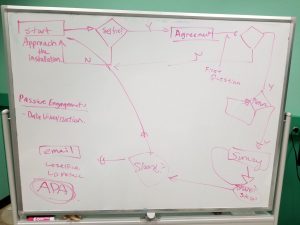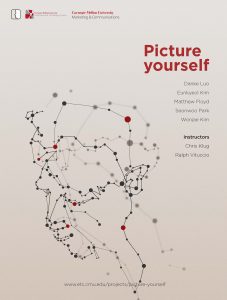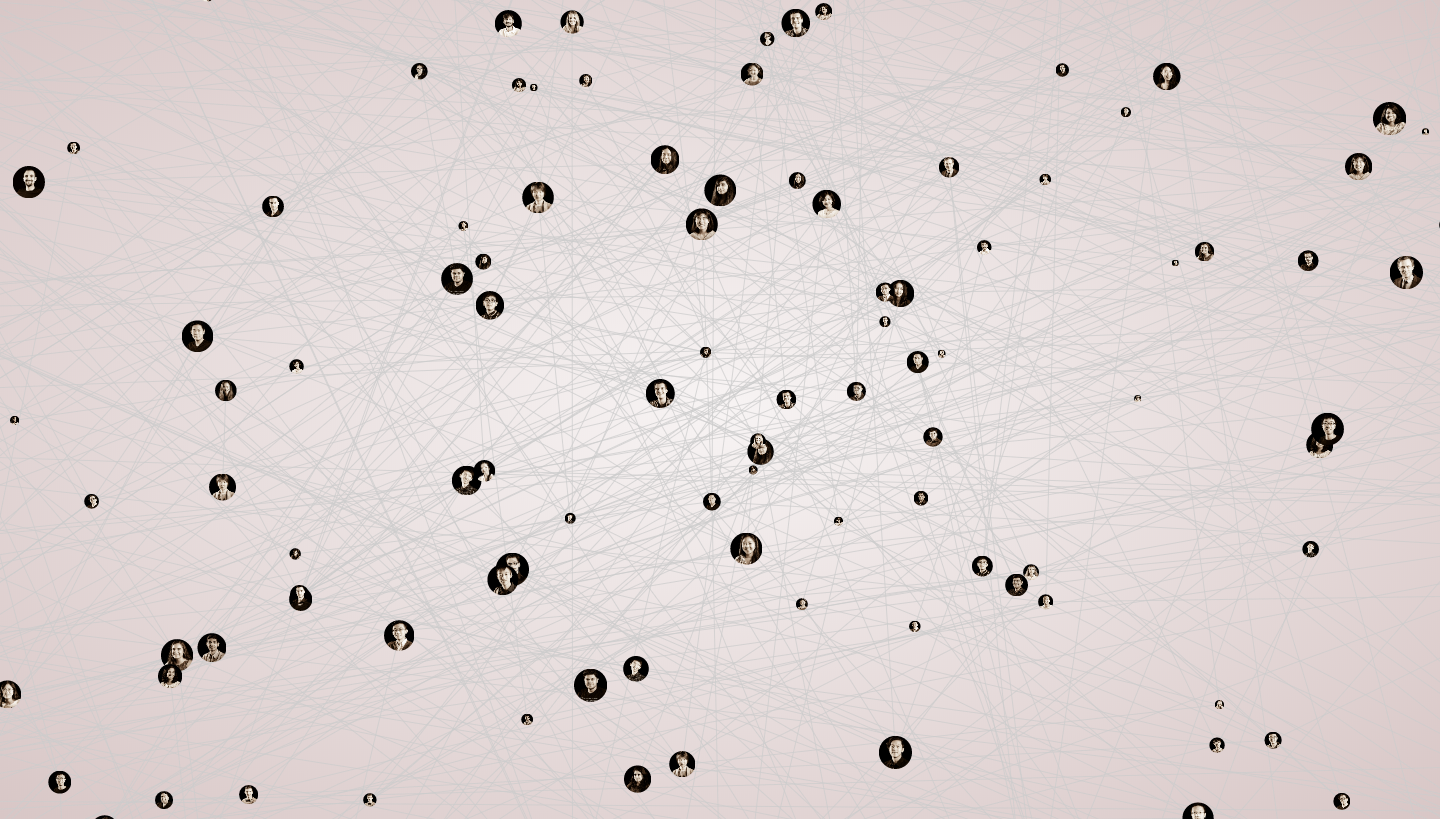The Work This Week:
During week four, we presented our research to CMU and got very positive feedback.
Client Discussion:
They were most excited about the interactive guestbook + selfie mosaic idea (as used in Portrait Machine). The idea that the exhibit is not just about the visitor, but about everyone in a way to evoke connection, is very powerful. Additionally, they were excited about the ability to build a living archive by collecting these pictures of students, alumni, and everyone else.
They confirmed that prospective students will make up the greatest number of the visitors, although events that alumni are invited to will also feature prominently.
Additionally, they were excited about the idea of using a globe or map to demonstrate global impact (before + after coming to CMU) and using it as subtext for education. They don’t want the exhibit to be a “watch this video,” “learn about CMU” kind of the thing. They said that if the learning is a passive add-on (like learning about CMU’s global impact), it creates the connection we’re discussing.
They also posed us interesting questions:
How would we collect student information?
What happens with people who put in fake information?
How do visitors share their photos?
For the first question, we discussed ideas on how to connect students outside themselves in the early stages of the exhibit. Prospective students might be reluctant to answer survey questions (they will mostly be wondering if they’ll fit , thinking if they’ll be successful, and wondering if they can afford CMU). So, we thought about collecting data from famous CMU alumni or faculty that students will be able to interact with (in the early stages of the exhibit before there is a lot of student photos in the archive).
Because, as our client pointed out, students often look at alumni success when thinking about a university. Seeing connected photos of famous alumni will connect them to CMU, and the exhibit, without being intrusive.
For the second question, we talked about making sure that tech will be available to override content. This will also be useful if specific marketing groups try to hijack it (i.e. trying to use the exhibit for specific research programs).
For the last question, we discussed that we don’t want the exhibit to be linked directly with social media platforms such as Facebook or Twitter, because this opens the door to potential hacking. So, for visitors to share their photos, we aim to go with the “email it to yourself” option.
Going forward, they mentioned groups that we could talk to, such as a Group of Student Ambassadors and an Alumni Relations Group, to further learn about what students and other users might want out of the exhibit, which was great to hear.
And, going forward with design, we were told that our budget number was indeed $150,000, and also got some clarifications on our design space. We cannot drill or adhere to the pillar, so it will be great if we can find a way to work it into our design. Same with the new color of the wall – it would be great if we could work with the new color, but we can repaint it if needed, because they don’t want to stifle ideas.
When we met with our advisers later in the week, we confirmed most of the positive feedback that our client was excited about, agreeing that we shouldn’t try to build around the pillar, and that we should start prototyping with the selfie mosaic idea, as that idea has gotten the best response so far.
Brainstorming the Visitor Journey:
Afterward, we got to work on thinking about which platforms to pursue, how to visualize our content, and the specific step-by-step journey we want our visitors to be taking.
For platforms, we want to think more about projection mapping, because it is clean, uses all the space, is less expensive, and hopefully will work the pillar naturally into a potential design. However, due to the fact that our space is not a dimly lit room, we’re worried about lighting as well as user interface. We believe that interfacing with a motion-detecting technology such as Kinect along with projection mapped content will be fine, but that would need to be playtested to confirm.
Additionally, we know that we can always use big TVs if projection mapping doesn’t work.
For visualization, we thought about how and where we want to use the map. Do we want the opening screen that visitors approach to be an oscillating screensaver between a map and an example selfie? Do we want visitors to be able to interact with a map to indicate where they are from? Should we have a physical, tangible globe as part of the exhibit, maybe sitting next to the pillar?
To answer these ideas, we focused on brainstorming the user/visitor journey, knowing that visualization can be based on augmenting those steps once they are in place:

- Visitors approach the installation and are asked if they want to take a photo
- If the visitor says no, the exhibit refreshes to the main opening screen
- If the visitor says yes, then once this consent is in place, the first question (i.e. “Where are you from?”) will be posed for the visitor to answer.
- The visitor then takes their picture. They can do this multiple times until they capture the exact photo they want.
- The first selfie mosaic (based on the first question) is then displayed. So, in the case of “Where are you from?” and the visitor answers “Pittsburgh,” then all other prior visitors from Pittsburgh will be displayed here in mosaic form. Having a preliminary mosaic is designed to keep the visitor engaged as to what the exhibit can offer in terms of establishing connection with other visitors.
- The visitor is then asked if they want to answer more survey questions.
- At this point, the visitor can answer as many randomized questions as they like, such as “What are you interested in?” or “Where do you want to live for your career?” and see themselves in as many mosaics as they want.
- Lastly, visitors have the option to email the photos to themselves. They can either email the photo just of them, or email the different mosaic they saw.
- We need to think more about places to make accommodations for visitors with disabilities as part of the A.D.A. This will also tie into how we visualize these steps going forward.
We brainstormed several questions to ask visitors, agreeing that “Where are you from?” and “What are you interested in?” are the most important questions. From there, we can ask questions about Pittsburgh life such as “What is your favorite Pittsburgh restaurant” or fun fun questions like “What is your favorite shape?” for visitors to explore. These are less important, however, than the main ones that will be used to establish the core fellowship between visitors.
Branding:
This week, we also finalized our internal branding materials based on faculty feedback to combine two of our previous drafts. We think it turned out very well!

Update:
One housekeeping thing. Two of our team members have conflicts of interest on Friday that, it turns out, are semester-long conflicts of interest. So, we adjusted our core hours accordingly:
Monday: 10AM – 6:15PM
Wednesday: 11AM – 6:15PM
Friday: 2:30PM – 7PM
Sorry for any inconvenience!
Going Forward:
We also are going to be talking with our client’s research groups next week to get more information about what visitors want to see. We also have 1/4 walkarounds next week, so we will also get feedback from the ETC faculty to confirm our next direction.
We did a lot this week and we look forward to the next one!

